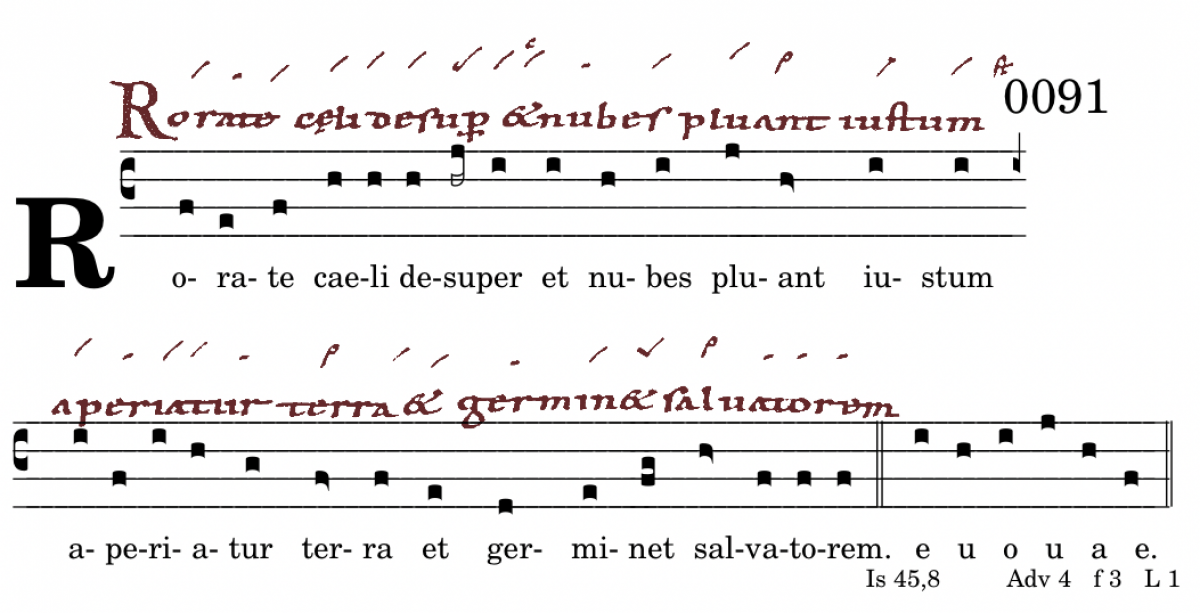🔘 IN GR TR AL OF CO xxxxx 1️⃣ 2️⃣ ✅ 3️⃣ 4️⃣ 5️⃣ 6️⃣ 7️⃣ 8️⃣ xxxxx AN RP IV alia
0091 AN Rorate caeli desuperModus Q
↖️
QINC 3acc celeriter
QMED statim
QNOV „terra“ Clv zum Cephalicus reduziert: „térra“ verbum acutum est.
QTER „si / sa“
Ungewöhnlich ist der Absprung zum „re“ am Schluss der Antiphon:
„sál-va-torem“. Das „re“ betont rückwirkend das Morphem „sál-vatorem“ und korreliert mit „terra“. Aus der Finalisebene, dem Boden der Antiphon (terra / -vatorem), erwächst der „sál“-vator.
In diesem Kontext ist auch das „fa“ bei „plu-ant„zu verstehen; der Unterschwung unter die Kadenzebene „sol“ ist logisch und bildhaft.
„germi-net“ kann nur „si“ sein mit Tol, Bv und Lc! Um es zynisch zu formulieren: die Virga Jesse ist kräftig genug einen Ganzton zu steigen. Die mystische Trübheit des 12., 13. und 19. Jahrhunderts passt nicht zu diesem Text. Warum sollte auch das bereits etablierte „si“ („aperia-tur“) verlassen/verändert werden.
Wichtig ist, die beiden litterae zu beachten: 'celeriter' lässt keine Gliederung zwischen erstem und zweitem Cento zu. „statim“ verlangt einen Abschluss der ersten Zeile, aber lässt kein meditierendes Verweilen zu. Die Antiphon treibt weiter, ist emotional hoch geladen und gleichzeitig doch schlicht.
● Tauet ihr Himmel von oben, ihr Wolken platscht den Gerechten.
Die Erde öffne sich und sprosse den Erlöser.
● Dew you heavens from above, you clouds splash the righteous.
Let the earth open and sprout the Saviour.
QINC 3acc celeriter
QMED statim
QNOV „terra“ Clv reduced to cephalicus: „térra“ verbum acutum est.
QTER „si / sa „
The jump to the „re“ at the end of the antiphon is unusual:
„sál-va-torem“. The „re“ retroactively emphasises the morpheme „sál-vatorem“ and correlates with „terra“. The „sál“-vator emerges from the finalis level, the bottom of the antiphon (terra / -vatorem).
The „fa“ in „plu-ant/“ is also to be understood in this context; the underswing below the cadential level „sol“ is logical and figurative.
„germi-net/“ can only be „si“ with Tol, Bv and Lc! To put it cynically: the virga Jesse is strong enough to rise a whole tone. The mystical gloom of the 12th, 13th and 19th centuries does not fit this text. Why should the already established „si“ („aperia-tur“) also be abandoned/changed.
It is important to note the two litterae: 'celeriter' does not allow a division between the first and second cento. „statim“ demands a conclusion to the first line, but does not allow for a meditative pause. The antiphon drives on, is emotionally charged and yet simple at the same time.
